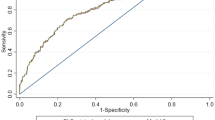Abstract
Summary
The US Preventative Services Task Force (USPSTF) recommends consideration for screening for osteoporosis in women under age 65 who have an estimated 10-year major osteoporotic fracture risk of 9.3 % or higher. We found that this threshold for osteoporosis screening in women ages 50–64 years old has a low sensitivity to detect osteoporosis.
Introduction
The US Preventative Services Task Force (USPSTF) recommends consideration of dual-energy X-ray absorptiometry (DXA) in women under ages 50–64 with a major osteoporotic fracture (MOF) risk of 9.3 % or higher, as estimated by the fracture risk assessment tool (FRAX) tool. We assessed the performance of the 9.3 % MOF risk threshold for detecting osteoporosis and evaluated whether DXA indication appeared appropriate, based on USPSTF criteria and other risk factors, at our institution.
Methods
We performed a retrospective record review of women ages 50–64.5 years old to determine clinical factors and FRAX scores of women undergoing a DXA at our institution over a 6-month period after the USPSTF recommendations were released and evaluated the sensitivity and specificity of the 9.3 % MOF threshold to detect densitometric osteoporosis. Additionally, using the USPSTF criteria and several additional risk factors, we evaluated the extent of potentially inappropriate DXA use in women ages 50 to 64 years in a large primary care practice in an academic medical center.
Results
The analysis included 465 DXA tests. The overall sensitivity and specificity of a FRAX-calculated MOF risk ≥9.3 % was 37 and 74 %, respectively, for the detection of osteoporosis. The receiver operator characteristic curve (ROC) demonstrated an area under the curve of 0.58. Lowering the FRAX risk threshold to 5.5 % would increase the sensitivity of detecting osteoporosis in our population from 37 to 80 % while reducing the specificity from 74 to 27 %. Out of 465 DXAs, 371 (79.8 %) were classified as appropriately ordered per our pre-specified criteria. Of the 120 women with osteoporosis at the hip and/or spine based on T-score values of −2.5 or less, 14 DXAs (11.7 %) were classified as potentially inappropriate based on a FRAX-predicted MOF risk less than 9.3 % and lack of additional pre-specified risk factors.
Conclusion
We found that the USPSTF-recommended MOF risk threshold of 9.3 % for osteoporosis screening in women ages 50–64 years old has a low sensitivity to detect osteoporosis.

Similar content being viewed by others
References
Foundation NO Clinician's Guide to Prevention and Treatment of Osteoporosis. http://nof.org/files/nof/public/content/file/2610/upload/895.pdf Accessed April 30, 2014
(2011) Screening for osteoporosis: U.S. preventive services task force recommendation statement. Ann Intern Med 154:356-364
Watts NB, Bilezikian JP, Camacho PM et al (2010) American Association of Clinical Endocrinologists Medical Guidelines for Clinical Practice for the diagnosis and treatment of postmenopausal osteoporosis: executive summary of recommendations. Endocr Pract 16:1016–1019
(2012) ACOG Practice Bulletin N. 129. Osteoporosis. Obstet Gynecol 120:718-734
Lim LS, Hoeksema LJ, Sherin K (2009) Screening for osteoporosis in the adult U.S. population: ACPM position statement on preventive practice. Am J Prev Med 36:366–375
FRAX™ WHO Fracture Risk Assessment Tool. https://www.shef.ac.uk/FRAX/tool.aspx Accessed January 22, 2014
WHO Scientific Group on the Assessment of Osteoporosis at Primary Health Care Level. http://www.who.int/chp/topics/Osteoporosis.pdf Accessed February 27 2013
Choosing Wiselytm An initiative of the ABIM Foundation. http://www.choosingwisely.org/ Accessed January 22, 2014
Qaseem A, Alguire P, Dallas P et al (2012) Appropriate use of screening and diagnostic tests to foster high-value, cost-conscious care. Ann Intern Med 156:147–149
Cadarette SM, Jaglal SB, Kreiger N, McIsaac WJ, Darlington GA, Tu JV (2000) Development and validation of the Osteoporosis Risk Assessment Instrument to facilitate selection of women for bone densitometry. CMAJ 162:1289–1294
Geusens P, Hochberg MC, van der Voort DJ, Pols H, van der Klift M, Siris E, Melton ME, Turpin J, Byrnes C, Ross P (2002) Performance of risk indices for identifying low bone density in postmenopausal women. Mayo Clin Proc 77:629–637
Mauck KF, Cuddihy MT, Atkinson EJ, Melton LJ 3rd (2005) Use of clinical prediction rules in detecting osteoporosis in a population-based sample of postmenopausal women. Arch Intern Med 165:530–536
Cadarette SM, Jaglal SB, Murray TM, McIsaac WJ, Joseph L, Brown JP (2001) Evaluation of decision rules for referring women for bone densitometry by dual-energy x-ray absorptiometry. JAMA 286:57–63
Crandall CJ, Larson J, Gourlay ML et al (2014) Osteoporosis screening in postmenopausal women 50 to 64 years old: comparison of US Preventive Services Task Force Strategy and Two Traditional Strategies in the Women's Health Initiative. J Bone Miner Res 29:1661–1666
Funding
Department funds were used for this study.
Conflicts of interest
None.
Author information
Authors and Affiliations
Corresponding author
Rights and permissions
About this article
Cite this article
Bansal, S., Pecina, J.L., Merry, S.P. et al. US Preventative Services Task Force FRAX threshold has a low sensitivity to detect osteoporosis in women ages 50–64 years. Osteoporos Int 26, 1429–1433 (2015). https://doi.org/10.1007/s00198-015-3026-0
Received:
Accepted:
Published:
Issue Date:
DOI: https://doi.org/10.1007/s00198-015-3026-0




